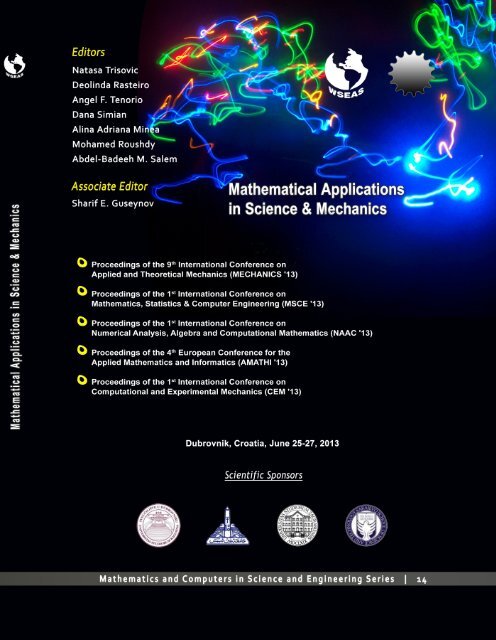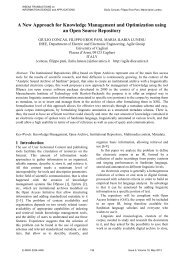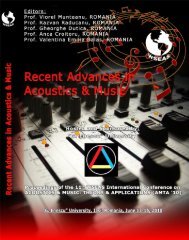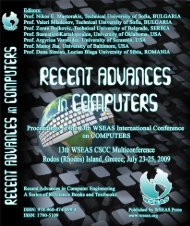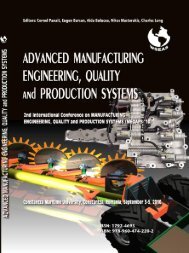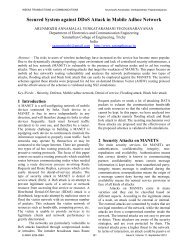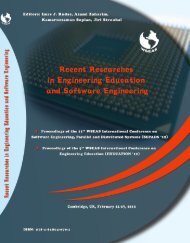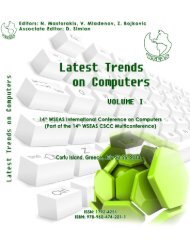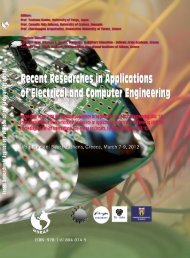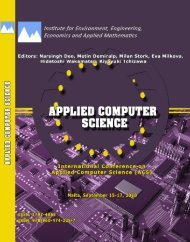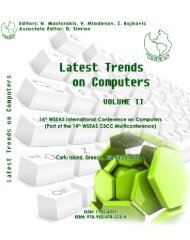Contents of this book - WSEAS
Contents of this book - WSEAS
Contents of this book - WSEAS
You also want an ePaper? Increase the reach of your titles
YUMPU automatically turns print PDFs into web optimized ePapers that Google loves.
MATHEMATICAL APPLICATIONSin SCIENCE and MECHANICSProceedings <strong>of</strong> the 9th International Conference on Applied andTheoretical Mechanics (MECHANICS '13)Proceedings <strong>of</strong> the 1st International Conference on Mathematics,Statistics & Computer Engineering (MSCE '13)Proceedings <strong>of</strong> the 1st International Conference on NumericalAnalysis, Algebra and Computational Mathematics (NAAC '13)Proceedings <strong>of</strong> the 4th European Conference for the AppliedMathematics and Informatics (AMATHI '13)Proceedings <strong>of</strong> the 1st International Conference on Computationaland Experimental Mechanics (CEM '13)Dubrovnik, CroatiaJune 25-27, 2013Published by <strong>WSEAS</strong> Presswww.wseas.orgCopyright © 2013, by <strong>WSEAS</strong> PressAll the copyright <strong>of</strong> the present <strong>book</strong> belongs to the World Scientific and Engineering Academy andSociety Press. All rights reserved. No part <strong>of</strong> <strong>this</strong> publication may be reproduced, stored in a retrievalsystem, or transmitted in any form or by any means, electronic, mechanical, photocopying, recording, orotherwise, without the prior written permission <strong>of</strong> the Editor <strong>of</strong> World Scientific and Engineering Academyand Society Press.All papers <strong>of</strong> the present volume were peer reviewed by no less that two independent reviewers.Acceptance was granted when both reviewers' recommendations were positive.See also: http://www.worldses.org/review/index.htmlISSN: 2227-4588ISBN: 978-960-474-305-6
MATHEMATICAL APPLICATIONSin SCIENCE and MECHANICSProceedings <strong>of</strong> the 9th International Conference on Applied andTheoretical Mechanics (MECHANICS '13)Proceedings <strong>of</strong> the 1st International Conference on Mathematics,Statistics & Computer Engineering (MSCE '13)Proceedings <strong>of</strong> the 1st International Conference on NumericalAnalysis, Algebra and Computational Mathematics (NAAC '13)Proceedings <strong>of</strong> the 4th European Conference for the AppliedMathematics and Informatics (AMATHI '13)Proceedings <strong>of</strong> the 1st International Conference on Computationaland Experimental Mechanics (CEM '13)Dubrovnik, CroatiaJune 25-27, 2013
Editors:Pr<strong>of</strong>. Natasa Trisovic, Belgrade University, SerbiaPr<strong>of</strong>. Deolinda Rasteiro, Instituto Superior de Engenharia de Coimbra, PortugalPr<strong>of</strong>. Angel F. Tenorio, Universidad Pablo de Olavide, SpainPr<strong>of</strong>. Dana Simian, University Lucian Blaga <strong>of</strong> Sibiu, RomaniaPr<strong>of</strong>. Alina Adriana Minea, Technical University Gheorghe Asachi <strong>of</strong> Iasi, RomaniaPr<strong>of</strong>. Mohamed Roushdy, Ain Shams University, EgyptPr<strong>of</strong>. Abdel-Badeeh M. Salem, Ain Shams University, EgyptAssociate Editor:Pr<strong>of</strong>. Sharif E. Guseynov, Transport and Telecommunication Institute, LatviaReviewers:Vipul Arvindbhai ShahSk. Sarif HassanMihai Tiberiu LatesHouman SaeGilbert-Rainer GillichNikos LoukerisVassos VassiliouTsvetelina DraganovaHamid Bashiri AtrabiBhagwati PrasadGeorgel ChiritaElena BautuGherghinescu SorinTakuya YamanoElena MereutaMonica CiobanuKandarpa Kumar SarmaArion FelixMatteo PalaiDavid NicoletaGabriella BognarDiana CotorosAlexandru FilipAw Yoke ChengPetr HajekMohamed ZahranIoana AdrianMaria WenischHung-Jen YangZanariah Abdul MajidDean TenengZaini AhmadCarla PintoSnezhana Georgieva Gocheva-IlievaVishnu Pratap Singh KirarSorinel OprisanHamed ZiaeipoorKannan K.Zeljko PanianDana AndersonAlper OzpinarNatasa TrisovicMorale TerryJose Alberto Duarte MollerMuhammet KoksalYuqing ZhouValeriy PerminovJosip MusicU. C. JhaNoor Fadiya Mohd NoorZakaria ZubiM. M. NoorMd. Shamim AkhterMihaela NeamtuTomas SedlacekIsmail IdrisKonstantin VolkovVasile CojocaruKevin Kam Fung YuenAamir Saeed MalikAnkit PatelYu ZhangNaveen G. RamunigariValeriu PrepelitaAlejandro Fuentes-PennaRoman Mihai DanielPaulo AvilaJiri HrebicekRoots LarissaEmmanuel Lopez-NeriIbrahim CanakDaniela LitanHumberto VarumHuashui ZhanAl Emran IsmailChunwei, Lu Wini LuJulian PuchetaAbdel-Badeeh SalemSwapnadip DeElena ZaitsevaLuís RoseiroSawsan EliasYong Kheng GohIsaac YeboahAlina Adriana MineaJose Manuel Mesa FernándezMaria DobritoiuGabriela MirceaMario TorcinaroSantoso Wibowo
Sorin GherghinescuGuoxiang LiuHime AguiarSatish Kumar DuraiswamyNagaraj S. V.Hugo RodriguesVasile MazilescuNitish GuptaYixin BaoMohammad Firoj MithaniMadalina XeniaAnca CroitoruHamideh EskandariBalu RamuTiberiu SocaciuEleazar Jimenez SerranoFayed F. M. GhalebCarlos E. FormigoniElena ScutelnicuMihaiela IliescuClaudia-Georgeta CarsteaClaudio GuarnacciaZengshi ChenPervez Ahmed
Mathematical Applications in Science and MechanicsTable <strong>of</strong> <strong>Contents</strong>Plenary Lecture 1: The Response <strong>of</strong> Railway Vehicles’ Mechanical Systems to ExcitationsAppearing During TravelIon Copaci11Plenary Lecture 2: Multi-Scale Nano-Mechanics 12K. M. LiewPlenary Lecture 3: Variational Principles for Topological Barotropic Fluid Dynamics 13Asher YahalomPlenary Lecture 4: Mechanical Design <strong>of</strong> Electrical Routing on Stretchable Substrate 14Hong HochengPlenary Lecture 5: Pareto Optimum in Bayesian Games 15Mihai Daniel RomanPlenary Lecture 6: Extenics Theory Applied to Robotics 16Luige VladareanuPlenary Lecture 7: Deterministic and Stochastic Advertising Diffusion Models 18Mihaela NeamtuPlenary Lecture 8: Neural Network and Fuzzy Logic Based Control <strong>of</strong> Induction Machines 19Dinko VukadinovićPlenary Lecture 9: Application <strong>of</strong> Wavelet Transformation, Mathematical Statistics and LinearEquations for Spectral and Image ProcessingTsvetelina DraganovaRecovery <strong>of</strong> Relaxation and Retardation Spectra over Expanded Intervals with IncreasedDensity <strong>of</strong> Spectrum PointsVairis Shtrauss2021Variational Principles for Topological Barotropic Fluid Dynamics 27Asher YahalomOn the Resistance <strong>of</strong> the Bearing Structures <strong>of</strong> Railway Vehicles 39Ion Copaci, Aurelia Tănăsoiu, Stelian Olaru, Bogdan TănăsoiuOn the Dynamic Experimental Determination <strong>of</strong> the Characteristics <strong>of</strong> Shock Insulators 47Stelian Olaru, Aurelia Tănăsoiu, Ion Copaci, Bogdan TănăsoiuStudy on the Lifetime <strong>of</strong> Metalic Helical Springs Used for the Suspensions <strong>of</strong> Road and RailwayVehiclesAurelia Tănăsoiu, Ion Copaci, Stelian Olaru, Bogdan Tănăsoiu51ISBN: 978-960-474-305-6 7
Mathematical Applications in Science and MechanicsAnalysis <strong>of</strong> Transient Load on Steel Envelope Structure 55Miroslav MynarzMotion Control <strong>of</strong> Vectored Thrust Aerial Vehicle for Enhanced Situational Awareness 59Igor Astrov, Mikhail Pikkov, Rein PaluojaApplication <strong>of</strong> Genetic Programming for Inverse Analysis <strong>of</strong> Moisture Transport in Blended-Cement MortarJan Kočí, Jiří Maděra, Zbyšek Pavlík, Jan Fořt, Robert ČernýThe Economic Maintenance Scheduling for a Batch Production System Considering Quality <strong>of</strong>the Processed ProductsJong Hun Park, Sang Cheon Lee, Hyung Rae Cho6570The Impact <strong>of</strong> Corruption upon Economic Growth in the U.E. Countries 76Mihai Daniel Roman, Madalina Ecaterina Andreica, Madalina Roxana OnutaRomanian Labour Market Efficiency Analysis 81Mihai Daniel Roman, Maria Denisa VasilescuIs Europe 2020 a Realistic Strategy for Sustainable Growth after the Crisis? 86Mihai Daniel Roman, Ioana Manafi, Daniela MarinescuDesign a Cost Effective Non-Holonomic Vehicle for Autonomous Driving Applications 91Hatem A. Darweesh, Mohamed Roushdy, Hala M. Ebied, Bassant M. ElbagouryRich Semantic Graph: A New Semantic Text Representation Approach for Arabic Language 97Sally S.Ismail, Mostafa Aref, Ibrahim MoawadEnhanced Approach with a Random Perturbation-Based Scheme (EARPB) for EstablishingAuthentic Associations in Wireless Mesh NetworkWalaa El-Salhy, Ahmed M. Khedr, Fayed F. M. GhalebApplication <strong>of</strong> Tikhonov's Regularization Method for Stable Finding the Diagnostic Matrix <strong>of</strong>GTE with A Priori Given Accuracy. Part I: Features <strong>of</strong> Diagnosing and Development <strong>of</strong>Mathematical ModelYunusov S. M., Guseynov Sh. E., Andreyev S. A., Labendik V. P.Application <strong>of</strong> Tikhonov's Regularization Method for Stable Finding the Diagnostic Matrix <strong>of</strong>GTE with A Priori Given Accuracy. Part II: Gas Path Analysis for Controlling the State <strong>of</strong>GTE Air Gas Channel with the Help <strong>of</strong> Tikhonov's Regularization MethodGuseynov Sh. E., Yunusov S. M., Andreyev S. A., Labendik V. P.Application <strong>of</strong> Tikhonov's Regularization Method for Stable Finding the Diagnostic Matrix <strong>of</strong>GTE with A Priori Given Accuracy. Part III: Development <strong>of</strong> Methods for the Determination<strong>of</strong> the Regularization ParameterAndreyev S. A., Guseynov Sh. E., Yunusov S. M., Labendik V. P.103109115121ISBN: 978-960-474-305-6 8
Mathematical Applications in Science and MechanicsThe Stability Analysis in a Chartist-Fundamentalist Model with Time Delays 211Gabriela Mircea, Mihaela Neamtu, Marilen G. PirteaExtenics Theory Applied to Robotics 217Luige Vladareanu, Paul Schiopu, Victor VladareanuActive Walking Mechatronic System for NeuroRehabilitation 225Petre Lucian SeiciuModal Analysis Applied to Milling Machines 231Marin DoinaPortfolio Choice: A Non Parametric Markovian Framework 237Enrico Angelelli, Sergio Ortobelli Lozza, Gaetano IaquintaModelling <strong>of</strong> the Multi-Agent Systems through Specific DEDS Methods and the ErlangFunctional LanguageEugen Diaconescu1, Luige Vladareanu243The Particle’s Trajectory – Implementation 249Dinka Lale, Vesna Županović, Ivan GrbavacContinuous Passive Motion Splint (Design and Control) 255Václav Sládeček, Josef Opluštil, Karel Frydrýšek, Jan Kráčmar, Roman Fousek, Leopold Pleva,Tomáš Kubín, Oldřich UčeňReport about the Temperature Stress-Strain States in Continuously Cast Bloom (FEMModelling and Experiments)Karel Frydrýšek, Miroslav Kvíčala259Report about Solutions <strong>of</strong> Beam on Nonlinear Elastic Foundation 263Karel Frydrýšek, Marek NikodýmAuthors Index 267ISBN: 978-960-474-305-6 10
Mathematical Applications in Science and MechanicsPlenary Lecture 1The Response <strong>of</strong> Railway Vehicles’ Mechanical Systems to Excitations Appearing DuringTravelPr<strong>of</strong>essor Ion CopaciEngineering Department“Aurel Vlaicu” UniversityArad, RomaniaE-mail: ioncopaci@gmail.comAbstract: Land vehicles, especially road and railway vehicles, travel on a specific surface, with sufficient uniquecharacteristics to demand a separate study. The research must define the nature <strong>of</strong> the excitations induced by thetravel way into the mechanical system <strong>of</strong> the vehicle. Also, depending on the vehicle, a choice <strong>of</strong> elastic elements likeshock and vibration absorbers is necessary such that the effect <strong>of</strong> excitations in the mechanical systems arediminished to an acceptable level. Support <strong>of</strong> the land vehicles is sufficiently similar to water in the case <strong>of</strong> navaltransport or air for aerial transportation, such that the nature <strong>of</strong> excitations is, in most cases, similar. The study <strong>of</strong>shocks and vibrations in each case is beneficial to all vehicles, not depending on the support on which they travel.The plight <strong>of</strong> eartquakes is also a problem <strong>of</strong> dynamics which has faced engineers, mathematicians and physicistswith the issue <strong>of</strong> reducing the response <strong>of</strong> a mechanical system to within acceptable boundaries (buildings,constructions that also suffer random loading due to wind, snow or other miscellaneous natures etc.). For towedrailway vehicles, a research program follows a path and a content that must be rigorously adhered to and to which,following my personal experience in research. I shall further refer.Brief Biography <strong>of</strong> the Speaker: Ion Copaci graduated from the “Traian Vuia” Polytechnic Institute in Timişoara,Romania, Faculty <strong>of</strong> Mechanics. He received his Ph.D. in the field <strong>of</strong> Mechanical Engineering with the thesis„Contributions on the Behaviour <strong>of</strong> the Bearing Structures <strong>of</strong> Railway Cars During the Longitudinal Shock Caused byCollision”, presented at the ”Politehnica” University Timişoara, Faculty <strong>of</strong> Mechanics, Department <strong>of</strong> Rolling Stock.Technical Experience: research in the area <strong>of</strong> vibrations and shocks on railway vehicles (rolling quality, repeatedshock), bearing structure resistance (lifetime, fatigue), elastic elements that equip the suspension or shock insulators<strong>of</strong> railway vehicles, torsional rigidity and travel safety, quantitative determinations (MATHAR) <strong>of</strong> the internal stresseson the bearing structures <strong>of</strong> bogies and Francis turbine rotors. Contributions and experimental research for thepromotion on the railway <strong>of</strong> over 150 freight and passenger railway car prototypes, in almost 30 countries on 5continents, as a result <strong>of</strong> over 40 years <strong>of</strong> research. Nowadays he is a Pr<strong>of</strong>essor at the Faculty <strong>of</strong> Engineering <strong>of</strong>“Aurel Vlaicu” University, Arad, Romania.Field <strong>of</strong> specialization: Railway Transport Vehicles, with disciplines taught: “Dynamics <strong>of</strong> Railway Vehicles” and“Experimental Research on Railway Vehicles”. He has published over 180 research papers, 7 <strong>book</strong>s and 5 inventor’slicences.He is a member <strong>of</strong> 8 societies and pr<strong>of</strong>essional associations and he is a member <strong>of</strong> the Ukrainian Academy <strong>of</strong>Science.ISBN: 978-960-474-305-6 11
Mathematical Applications in Science and MechanicsPlenary Lecture 2Multi-Scale Nano-MechanicsPr<strong>of</strong>essor K. M. LiewDepartment <strong>of</strong> Civil and Architectural EngineeringCity University <strong>of</strong> Hong KongHong Kong SARE-mail: kmliew@cityu.edu.hkAbstract: Nano-mechanics has been emerging as a new researching domain that excited a considerable interest inthe condensed-matter and materials research communities. Due to the difficulty in the theoretical and experimentalinvestigations <strong>of</strong> nanostructures, numerical modeling and simulation play an important role in capturing their finebehavior and revealing their delicate properties. The particularity <strong>of</strong> nanostructure brings a challenge to theconventional computational method. For example, a simple nanostructure, such as a MWCNT, involves thousands <strong>of</strong>atoms that lead to too many degrees <strong>of</strong> freedom, and atom-based modeling method, such as molecular dynamic,consumes a huge amount <strong>of</strong> computational time. This fact also stimulated the exploration and development <strong>of</strong> thenew computational techniques in the computational nano-mechanics, such as continuum modeling and multi-scalemethods. This talk will address the applications <strong>of</strong> continuum and molecular dynamics models for modeling <strong>of</strong> carbonnanotubes. Numerical discretization <strong>of</strong> these continuum models and the developed multi-scale computational schemewill be discussed.Brief Biography <strong>of</strong> the Speaker: Pr<strong>of</strong>essor Liew jointed the City University <strong>of</strong> Hong Kong in 2005 as a ChairPr<strong>of</strong>essor <strong>of</strong> Civil Engineering. Currently he is the Head <strong>of</strong> the Department <strong>of</strong> Civil and Architectural Engineering. Hewas formerly a tenured pr<strong>of</strong>essor at Nanyang Technological University, Singapore. His research activities encompassnano-mechanics, materials modeling, multi-scale analysis, and large-scale simulation and visualization. In recentyears, he and his research group have been actively involved in the theoretical research <strong>of</strong> nano-materials, inparticular CNTs, by employing molecular dynamics and continuum approaches, and multi-scale method. He haspublished over 550 journal articles. He is a Fellow <strong>of</strong> ASME and IMechE. His current h-index is over 50 and he iscited by the Institute for Scientific Information (ISI) as one <strong>of</strong> the highly cited researchers in engineering.ISBN: 978-960-474-305-6 12
Mathematical Applications in Science and MechanicsPlenary Lecture 3Variational Principles for Topological Barotropic Fluid DynamicsPr<strong>of</strong>essor Asher YahalomIsaac Newton Institute for Mathematical Sciences, 20 Clarkson Road,Cambridge CB3 0EH, United KingdomAriel University Center <strong>of</strong> Samaria, Ariel 40700IsraelE-mail: asya@ariel.ac.ilAbstract: Barotropic fluid flows with the same circulation structure as steady flows generically have comovingphysical surfaces on which the vortex lines lie. These become Bernoullian surfaces when the flow is steady. Whenthese surfaces are nested (vortex line foliation) with the topology <strong>of</strong> cylinders, toroids or a combination <strong>of</strong> both, weshow how a Clebsch representation <strong>of</strong> the flow velocity can be introduced. This is then used to reduce the number <strong>of</strong>functions to be varied in the variational principles for such flows. I introduce a three function variational formalism forstationary and non-stationary barotropic flows.Brief Biography <strong>of</strong> the Speaker: Asher Yahalom is an Associate Pr<strong>of</strong>essor in the Faculty <strong>of</strong> Engineering at the ArielUniversity Center <strong>of</strong> Samaria and the Academic director <strong>of</strong> the free electron laser user center which is located withinthe University Center campus. He was born in Israel on November 15, 1968, received the B.Sc., M.Sc. and Ph.D.degrees in mathematics and physics from the Hebrew University in Jerusalem, Israel in 1990, 1991 and 1996respectively. From 1994 to 1998 Asher Yahalom worked with Direx Medical System on the development <strong>of</strong> a novelMRI machine as a head <strong>of</strong> the magneto-static team. Afterwards he consulted the company in various mathematicaland algorithmic issues related to the development <strong>of</strong> the “gamma knife” - a radiation based head surgery system. Inthe years 1998-1999 Asher Yahalom joined the Israeli Free Electron Laser Group both as postdoctoral fellow and asa project manager, he is a member <strong>of</strong> the group ever since. In 1999 he joined the College <strong>of</strong> Judea & Samaria whichbecame at 2007 Ariel University Center. During 2005-2006 on his first sabbatical he was a senior academic visitor atthe institute <strong>of</strong> astronomy in Cambridge. Currently during his second sabbatical he is a visiting fellow <strong>of</strong> the IsaacNewton Institute for Mathematical Sciences also in Cambridge UK. Asher Yahalom works in a wide range <strong>of</strong> scientific& technological subjects ranging form the foundations <strong>of</strong> quantum mechanics to molecular dynamic, fluid dynamics,magnetohydrodynamics, electromagnetism and communications.ISBN: 978-960-474-305-6 13
Mathematical Applications in Science and MechanicsPlenary Lecture 4Mechanical Design <strong>of</strong> Electrical Routing on Stretchable SubstratePr<strong>of</strong>essor Hong HochengCo-author: C.-M. ChenDepartment <strong>of</strong> Power Mechanical EngineeringNational Tsing Hua UniversityHsinchu, TaiwanE-mail: hocheng@pme.nthu.edu.twAbstract: Stretchable electrical devices, unlike solid and flexible electrical devices, possess high mechanicalstretchability in plane that are essentally advantageous for innovative biomedical and textile applications. In last tenyears, the design development <strong>of</strong> mechanics for stretchable electronics has been dedicated to solve for twoproblems: improving the conductivity while increasing the strain tolerance <strong>of</strong> the electrical routing. According to theadopted routing geometry and fabrication process, various designs can be divided into five patterns: straight; wavy;wrinkly; bridge-like; and conductive-elastomeric. The geometric function <strong>of</strong> a specified routing form can be analyzedby finite element simulation and the experimental tensile test. The authors find that the strain limit at wire-breaking isdetermined by width-to-radius ratio, route angle and wire thickness. Larger angle and thickness with lower width-toradiusratio provide higher strain limit. The influences are examined and a mathematical function predicting themaximum strain is derived. Furthermore, a fabrication method incorporating the pre-strainis is proposed, that supplieshigher stretchability for the electrical routing.Brief Biography <strong>of</strong> the Speaker: Pr<strong>of</strong>essor H. Hocheng earned his Diplom-Ing. from Technische Hochschule atAachen and Ph.D. from University <strong>of</strong> California at Berkeley in mechanical engineering. He has been University ChairPr<strong>of</strong>essor at National Tsing Hua University. He received numerous national and international research awards andare Fellows <strong>of</strong> ASME and AMME. His research interest lies in the area <strong>of</strong> innovative materials processing technoogy.ISBN: 978-960-474-305-6 14
Mathematical Applications in Science and MechanicsPlenary Lecture 5Pareto Optimum in Bayesian GamesPr<strong>of</strong>essor Mihai Daniel RomanThe Faculty <strong>of</strong> CyberneticsStatistics and Economic InformaticsThe Bucharest University <strong>of</strong> Economic StudiesRomaniaE-mail: mihai.roman@ase.roAbstract: The solutions provided by Game Theory are usually specific for different types <strong>of</strong> games and start fromNash solutions. The Nash equilibrium is specific for non cooperative static games in complete information, PerfectSubgame Equilibrium corresponds to non cooperative sequential games in complete and perfect information, Bayes-Nash equilibrium is specific for static non cooperative games in incomplete information and Perfect Bayes-Nashequilibrium for dynamic non cooperative games in incomplete information. A Nash equilibrium (or different forms <strong>of</strong>them) basically represents a set <strong>of</strong> strategies where each player tries to maximize his or her pay<strong>of</strong>f depending ontheir own strategies and given the possible strategies <strong>of</strong> the others. Usually, there are not exists a direct relationbetween Nash equilibrium and Pareto optimal solutions (defining Pareto optimal solution as the state where it is notpossible to improve the one player pay<strong>of</strong>f without making the other players’ pay<strong>of</strong>f worse). One <strong>of</strong> the most importantexamples <strong>of</strong> <strong>this</strong> situation is Prisoner Dilemma, where Nash equilibrium is not Pareto optimal. But it is well known thatevery game has at least one Pareto optimal pr<strong>of</strong>ile that is not necessary a Nash equilibrium). In the case <strong>of</strong> noncooperative static game in complete information there are a few games categories (like coordination games) where itis possible to implement Pareto optimum solutions as Nash equilibriums. The case <strong>of</strong> non cooperative games incomplete and perfect information confirms the possibility to obtain Perfect Subgame Equilibrium outside Paretooptimal solutions. One particular situation is in the case <strong>of</strong> repeated (finite or infinite) games where it is possible toobtain both Pareto optimum and Perfect Subgame Equilibrium for the same set <strong>of</strong> strategies (under conditionsestablished in folk theorem). Also the Perfect Bayes Nash Equilibriums that corresponds to dynamic non cooperativegames in incomplete information usually do not correspond to Pareto optimum without specific constraints. Moreover,in the case <strong>of</strong> dynamic mechanism design games, it fails to be fully Pareto optimal and incentive compatible and isalso not implementable as a perfect Bayes - Nash equilibrium <strong>of</strong> an extensive form game. The correspondencebetween Bayes-Nash equilibrium and Pareto optimum for static non cooperative games in incomplete informationwas less studied in literature. In our study we analyze different types <strong>of</strong> Bayesian games (like mechanism designgames, moral hazard games, adverse selection games or auction games) and we verify the relation between Bayes –Nash equilibrium and Pareto optimum. The main result was that under incomplete information it is not possible toimplement the Pareto optimum (or the first best optimum) simultaneously with Bayes – Nash equilibrium (that usuallywas the second best optimum).Brief Biography <strong>of</strong> the Speaker: Mihai Daniel Roman is a full pr<strong>of</strong>essor <strong>of</strong> Game Theory and Macroeconomics atThe Faculty <strong>of</strong> Cybernetics, Statistics and Economic Informatics, The Bucharest University <strong>of</strong> Economic Studies,Romania. He received his master degree in 1994 at the Université de Sciences Sociales, Toulouse, France,specialization Quantitative Economics and the Ph. D. in 1997 at The Bucharest University <strong>of</strong> Economic Studies in thefield <strong>of</strong> Economic Cybernetics. His scientific interests are primarily focused on Game Theory, Macroeconomics andQuantitative Economic Analysis. As a director, he has conducted more than twenty national research projects, hepublished more than thirty papers in international prestigious journals, he presented more than one hundred andtwenty papers at international and national conferences and he wrote twenty four <strong>book</strong>s. He is a member <strong>of</strong> theeditorial board in six database indexed international journals. He is also the director <strong>of</strong> the Advanced ResearchCenter for Microeconomic and Macroeconomic Cybernetic Analysis and he organized eight international conferencesin the field <strong>of</strong> economic cybernetic analysis. Since 2012 he has been elected the Vice-president <strong>of</strong> The BucharestUniversity <strong>of</strong> Economic Studies Senate.ISBN: 978-960-474-305-6 15
Mathematical Applications in Science and MechanicsPlenary Lecture 6Extenics Theory Applied to RoboticsPr<strong>of</strong>essor Luige VladareanuHead <strong>of</strong> Robotics and Mechatronics DepartmentRomanian Academy, Institute <strong>of</strong> Solid MechanicsBucharest, RomaniaE-mail: luigiv@arexim.roAbstract: Extenics is a novel theoretical frame <strong>of</strong> matter element in the world leading science, which establishes themethodology <strong>of</strong> solving contradictory problems through the intelligent and innovative process in a formal,mathematical and logical way. Starting from the theoretical frame and having pillars the basic-element theory,extension set theory and extension logic, the special extension methodology are presented. The extensibility <strong>of</strong>matter-element including the divergent, conjugate, correlative, implicative and expansive nature are analyzed inrobotics fields. The quantitative tools to solve the robotics contradictory problems based on extension set <strong>of</strong> extensionmathematics are examined. Extension decision methods on robot control field are done by applying a series <strong>of</strong>comprehensive strategies using extension set and dependent function in order to transformations <strong>of</strong> goal matterelementsor condition matter-elements in consistency elements and rules <strong>of</strong> cognitive reasoning. The roboticsintelligent control by extension theory and the basic concepts, structure and principles <strong>of</strong> extension control developedas the knowledge base, the characteristics pattern recognition, fusion <strong>of</strong> dependent degree on characteristic states,the measure pattern recognition, the adaptive mechanism, the control strategies as the main elements <strong>of</strong> the controlsystem architecture. Finally, an advanced method is developed for solving contradictory problems in the motioncontrol <strong>of</strong> autonomous robots by applying extension theory on a multi-dimensional space using non-linear attractionpoint principle and the network <strong>of</strong> attraction curves. The obtained results lead to development <strong>of</strong> a methodology thatallows obtaining high level results for robot motion control using extended transformations onto the extension set andan optimization function generated by the extended dependence function in multidimensional space in comparison tothe classical method using sequential logic matrices.Brief Biography <strong>of</strong> the Speaker: Luige Vladareanu received Ph.D. degree in electronics field from the Institute <strong>of</strong>Solid Mechanics <strong>of</strong> Romanian Academy, in 1998. From 2003, Ministry <strong>of</strong> Education and Research, executiveDepartment for Financing Superior Education and <strong>of</strong> Scientific University Research - High Level Expert Consulting forMEC/CNCSIS project, from 2003-2005, member <strong>of</strong> Engineering Science Committee <strong>of</strong> Romanian National ResearchCouncil, from 2005, Scientific Researcher Gr.I (Pr<strong>of</strong>essor) <strong>of</strong> Romanian Academy, from 2009 Head <strong>of</strong> Robotics andMechatronics Department <strong>of</strong> Institute <strong>of</strong> Solid Mechanics, Romanian Academy. His scientific work is focused on realtime control in solid mechanics applied in robot trajectory control, hybrid position – force control, multi-microprocessorsystems for robot control, acquisition and processing <strong>of</strong> experimental physical data, experimental methods and signalprocessing, nano-micro manipulators, semi-active control <strong>of</strong> mechanical system vibrations, semi-active control <strong>of</strong>magnetorheological dissipaters systems, complex industrial automations with programmable logical controllers indistributed and decentralized structure. He has published over 35 <strong>book</strong>s and <strong>book</strong> chapters, 19 edited <strong>book</strong>s, over200 papers in journals, proceedings and conferences in the areas. Director and coordinator <strong>of</strong> over 15 grants <strong>of</strong>international and national research – development programs in the last 5 years, 15 invention patents, developing 17advanced work methods resulting from applicative research activities and more then 60 research projects. He is thewinner <strong>of</strong> the two Prize and Gold <strong>of</strong> Excellence in Research 2000, SIR 2000, <strong>of</strong> the Romanian Government and theAgency for Science, Technology and Innovation. 9 International Invention and Innovation Competition Awards andGold <strong>of</strong> World’s Exhibition <strong>of</strong> Inventions, Geneva 2007 - 2009, and other 9 International Invention Awards and Gold <strong>of</strong>the Brussels, Zagreb, Bucharest International Exhibition. He received “Traian Vuia” (2006) award <strong>of</strong> the RomanianAcademy, Romania’s highest scientific research forum, for a group <strong>of</strong> scientific papers published in the real timecontrol in the solid mechanics. He is a member <strong>of</strong> the International Institute <strong>of</strong> Acoustics and Vibration (IIAV), AuburnUniversity, USA (2006), ABI´s Research Board <strong>of</strong> Advisors, American Biographical Institute (2006), World Scientificand Engineering Academy Society, <strong>WSEAS</strong> (2005), International Association for Modelling and SimulationTechniques in Enterprises - AMSE, France (2004), National Research Council from Romania(2003-2005), etc. He isa PhD advisor in the field <strong>of</strong> mechanical engineering at the Romanian Academy. He was an organizer <strong>of</strong> severalISBN: 978-960-474-305-6 16
Mathematical Applications in Science and Mechanicsinternational conferences such as the General Chair <strong>of</strong> four <strong>WSEAS</strong> International Conferences(http://www.wseas.org/conferences/2008/romania/amta/index.html), chaired Plenary Lectures to Houston 2009,Harvard, Boston 2010 and Penang, Malaysia 2010, Paris 2011 to the <strong>WSEAS</strong> International Conferences, is teamleader <strong>of</strong> <strong>WSEAS</strong> scientific research project: Mechanics & Robotics Systems and is serving on various otherconferences and academic societies.ISBN: 978-960-474-305-6 17
Mathematical Applications in Science and MechanicsPlenary Lecture 7Deterministic and Stochastic Advertising Diffusion ModelsPr<strong>of</strong>essor Mihaela NeamtuFaculty <strong>of</strong> Economics and Business AdministrationWest University <strong>of</strong> TimisoaraRomaniaE-mail: mihaela.neamtu@feaa.uvt.roAbstract: The paper presents two advertising diffusion models described by systems <strong>of</strong> nonlinear differentialequations, where a firm devotes a fixed proportion <strong>of</strong> sales to advertising. In the first model the customers go througha two-stage adoption process, from non-adopter to adopter under the influence <strong>of</strong> word-<strong>of</strong>-mouth and advertising.There is time delay in the advertising response. In the second model the customers go through a three-stageadoption process: non-adopter-thinker-adopter. The thinker population is exposed to advertisement and will becomeadopter after some delay. For both models, the deterministic and stochastic versions are described. First, for thedeterministic models, the equilibrium points are analyzed. Also, the stability <strong>of</strong> the Hopf bifurcation is provided. Forthe linearized perturbed stochastic system, the differential equations for the square mean values are identified andtheir dynamics are studied. The last part includes numerical simulations and conclusions.Brief Biography <strong>of</strong> the Speaker: Mihaela Neamtu was born in Timisoara (Romania) on 1971. She graduated in1995 the Faculty <strong>of</strong> Mathematics, West University <strong>of</strong> Timisoara. In 2001 she obtained the title <strong>of</strong> Ph.D inmathematics. She followed a didactic career at the Faculty <strong>of</strong> Economics and Business Administration, WestUniversity <strong>of</strong> Timisoara, Romania and she is currently a pr<strong>of</strong>essor. She has been a visiting Pr<strong>of</strong>essor for short periods<strong>of</strong> time at The Nottingham Trent University, Economics & Politics (Great Britain) and Faculty <strong>of</strong> Mathematics, Bonn(Germany). Pr<strong>of</strong>essor Mihaela Neamtu has over 70 articles published in Journals and Proceedings <strong>of</strong> theInternational Conferences and 5 monographs; she has been a regular referee <strong>of</strong> papers for several InternationalJournals and a reviewer <strong>of</strong> Mathematical Reviews (MathSciNet). She has been participating in 12 multiannual grants(1 <strong>of</strong> them is international), in 9 as a member and in 2 as a director. Her main academic interests are in dynamicalsystems and applications in biology and economy.ISBN: 978-960-474-305-6 18
Mathematical Applications in Science and MechanicsPlenary Lecture 8Neural Network and Fuzzy Logic Based Control <strong>of</strong> Induction MachinesPr<strong>of</strong>essor Dinko VukadinovićFaculty <strong>of</strong> Electrical Engineering, Mechanical Engineering and Naval ArchitectureUniversity in SplitCroatiaE-mail: dvukad@fesb.hrAbstract: Induction motors have been used as the workhorse in industry for a long time due to their being easy tobuild, highly robust, and having generally satisfactory efficiency. In addition, induction generators play an importantrole in renewable energy systems such as energy systems with variable-speed wind turbines.The induction machine is a nonlinear multivariable dynamic system with parameters that vary with temperature,frequency and magnetic saturation. Considering that neural networks are capable <strong>of</strong> handling time varyingnonlinearities due to their own nonlinear nature, they are suitable for application in induction machine systems. Thislecture presents a brief review <strong>of</strong> applications <strong>of</strong> artificial neural networks and fuzzy logic for induction machines.Most applications <strong>of</strong> neuro and/or fuzzy theory in induction machine control systems focus on advanced controllersfor speed, position or voltage, where the conventional PI controller is replaced by a neuro and/or fuzzy controller. Fewother applications will also be shown in <strong>this</strong> lecture, such as: neural network-based speed estimator, neural networkbasedinverter control, applications <strong>of</strong> neural networks in waveform processing and delayless filtering, identification <strong>of</strong>machine parameters based on fuzzy/neural concepts and approaches for the efficiency improvement in inductionmachine systems. Some <strong>of</strong> the presented simulation and experimental results are obtained at the Researchlaboratory for Power Electronics <strong>of</strong> the Faculty <strong>of</strong> Electrical Engineering, Mechanical Engineering and NavalArchitecture in Split, Croatia.Brief Biography <strong>of</strong> the Speaker: Dinko Vukadinović received the B.E. degree from the University <strong>of</strong> Split, the M.E.degree from the University <strong>of</strong> Zagreb and the Ph.D. degree from the University <strong>of</strong> Split, Croatia, in 1997, 2002 and2005, respectively, all in electrical engineering. In 1998, he joined the University <strong>of</strong> Split, Faculty <strong>of</strong> ElectricalEngineering, Mechanical Engineering and Naval Architecture (FESB), Department <strong>of</strong> Electric Power Engineering as ajunior researcher. In 2013, he became a Full Pr<strong>of</strong>essor at the University <strong>of</strong> Split. In 2009, he was appointed Chair <strong>of</strong>Power Electronics and Control at the University <strong>of</strong> Split, FESB.He is an Associate Editor <strong>of</strong> the Journal <strong>of</strong> Computer Science, Informatics and Electrical Engineering, and a member<strong>of</strong> the Editorial board <strong>of</strong> the Journal <strong>of</strong> Convergence Information Technology, Electrical and Electronic Engineeringand International Journal <strong>of</strong> Innovative Research & Development.His current research interests include induction machine control systems, power electronics, digital signal processorsand artificial intelligence.He has published one <strong>book</strong> and more than 20 papers in scientific journals and conferences. Also, he was the editor <strong>of</strong>two <strong>book</strong>s published by Nova Science Publishers Inc.ISBN: 978-960-474-305-6 19
Mathematical Applications in Science and MechanicsPlenary Lecture 9Application <strong>of</strong> Wavelet Transformation, Mathematical Statistics and Linear Equations forSpectral and Image ProcessingAssociate Pr<strong>of</strong>essor Tsvetelina DraganovaDepartment <strong>of</strong> Automatics and MechatronicsUniversity <strong>of</strong> RuseBulgariaE-mail: cgeorgieva@uni-ruse.bgAbstract: Spectral and image processing depend on application and area where we have to use. Methods based onwavelet transformation, mathematical statistics and linear equations are proposed for feature extraction <strong>of</strong> objects inprecision farming using spectral and image characteristics. Neural networks and Fuzzy logic are used forclassification <strong>of</strong> the objects in quality groups.Brief Biography <strong>of</strong> the Speaker: Tsvetelina Draganova is graduated with a M.S. degree in Automatics fromUniversity <strong>of</strong> Ruse, Bulgaria in 2001, and then with a M.S. degree in Computer Science and Technologies fromUniversity <strong>of</strong> Ruse, Bulgaria in 2003. She has a doctoral degree in the field <strong>of</strong> Automation from 2007. From 2007 shehas been a faculty member <strong>of</strong> the Department <strong>of</strong> Automatics and Mechatronics at the University <strong>of</strong> Ruse, Bulgaria,serving as an assistant pr<strong>of</strong>essor from 2007 to May 2012, and an associate pr<strong>of</strong>essor since May 2012. The researchinterests <strong>of</strong> Tsvetelina Draganova include image processing, spectral data analysis, chemometrics, wavelettransformation, linear equations, neural networks, industrial networks and programmable logic controllers. She isauthor <strong>of</strong> a few <strong>book</strong>s and more than 40 papers published in international journals and conference proceedings.ISBN: 978-960-474-305-6 20
Mathematical Applications in Science and MechanicsAuthors IndexAli, O. M. 152 Iaquinta, G. 237 Pavlík, Z. 65Amornsamankul, S. 200 Ismail, S. S. 97 Pikkov, M. 59Andreica, M. E. 76 Kerh, T. 175 Pirtea, M. G. 211Andreyev, S. A. 109, 115, 121 Khedr, A. M. 103 Pleva, L. 255Angelelli, E. 237 Kočí, J. 65 Polić, M. 189Aref, M. 97 Kočí, V. 158 Roman, M. D. 76, 81, 86Astrov, I. 59 Kráčmar, J. 255 Roushdy, M. 91Baranova, L. V. 127 Kubín, T. 255 Saengpayab, Y. 200Bascelija, N. 164 Kvíčala, M. 259 Saunders, R. 175Bašić, M. 189, 195 Labendik, V. P. 109, 115, 121 Schiopu, P. 217Birău, R. 140, 146 Lale, D. 249 Seiciu, P. L. 225Caraus, I. 170 Lee, S. C. 70 Shedeed, H. A. 152Černý, R. 65, 158 Lin, Y. T. 175 Shtrauss, V. 21Cho, H. R. 70 Lozza, S. O. 237 Sirghi, N. 205Copaci, I. 39, 47, 51 Maděra, J. 65 Sládeček, V. 255Darweesh, H. A. 91 Manafi, I. 86 Sultanic, S. 134Diaconescu1, E. 243 Marinescu, D. 86 Tănăsoiu, A. 39, 47, 51Doina, M. 231 Mastorakis, N. E. 170 Tănăsoiu, B. 39, 47, 51Ebied, H. M. 91 Medvedev, A. N. 127 Tolba, M. F. 152Ehsanifar, M. 140 Mircea, G. 211 Triampo, W. 200Elbagoury, B. M. 91 Moawad, I. 97 Trivedi, J. 146El-Salhy, W. 103 Mohammadi, H. 140 Učeň, O. 255Fořt, J. 65 Mynarz, M. 55 Vasilescu, M. D. 81Fousek, R. 255 Nakagiri, S.-I. 181 Vladareanu, L. 217, 243Frydrýšek, K. 255, 259, 263 Neamtu, M. 205, 211 Vladareanu, V. 217Gadalla, M. 152 Nikodým, M. 263 Vukadinović, D. 189, 195Geru, V. 170 Nokkaew, A. 200 Yahalom, A. 27Ghaleb, F. F. M. 103 Olaru, S. 39, 47, 51 Yunusov, S. M. 109, 115, 121Grbavac, I. 249 Onuta, M. R. 76 Županović, V. 249Grbin, S. 195 Opluštil, J. 255Guseynov, Sh. E. 109, 115 Paluoja, R. 59Guseynov, Sh. E. 121, 127 Park, J. H. 70ISBN: 978-960-474-305-6 267


